The 21214-10 engine was created on the basis of the 21213 engine. They have the same body parts and crank mechanism. The same suspension of the power unit. Differences in the engine design are associated with the use of a multiport fuel injection system on this engine instead of a carburetor, using hydraulic pushrod supports and a hydraulic chain tensioner in the gas distribution mechanism. Therefore, there are features in the assembly and disassembly of the engine, in terms of removing and installing air supply units, power systems and lubrication systems.
Removal and installation of the power unit
Before removing the power unit, it is necessary to remove the pressure in the fuel supply system. To do this, disconnect the fuel pump wiring harness connector from the injection system wiring harness, start the engine, let it run until it stops, and then turn on the starter for 3 seconds to equalize the pressure in the pipelines.
Disconnect the wire from the outlet «minus» battery.
Disconnect hoses 7 and 8 (pic. 9-14) supply and drain of fuel from tubes 1 and 9 on the engine. Close the openings of the hoses and tubes to prevent dirt from entering them.
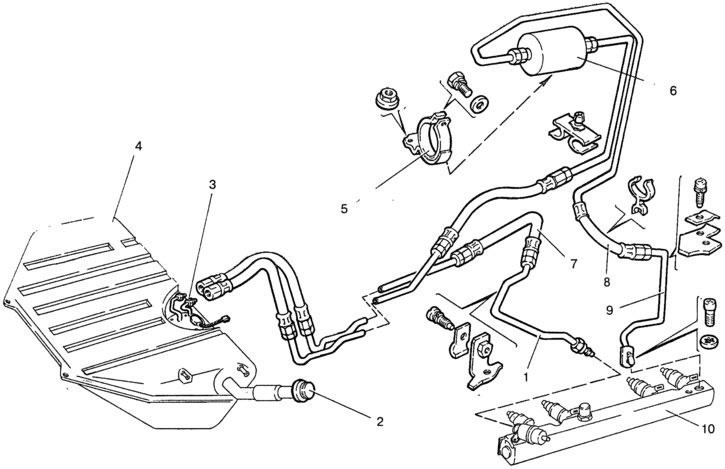
Pic. 9-14. Fuel tank parts and fuel lines:
1 - outlet tube; 2 - cork; 3 - electric fuel pump; 4 - fuel tank; 5 - bracket for fastening the fuel filter; 6 - fuel filter; 7 - drain hose of the fuel line; 8 - fuel supply hose; 9 - fuel supply pipe; 10 - fuel rail.
Disconnect cable 4 (pic. 9-15) accelerator drive from bracket 5 on the throttle pipe, from sector 6 on the receiver and from bracket 3 on the cylinder head cover.
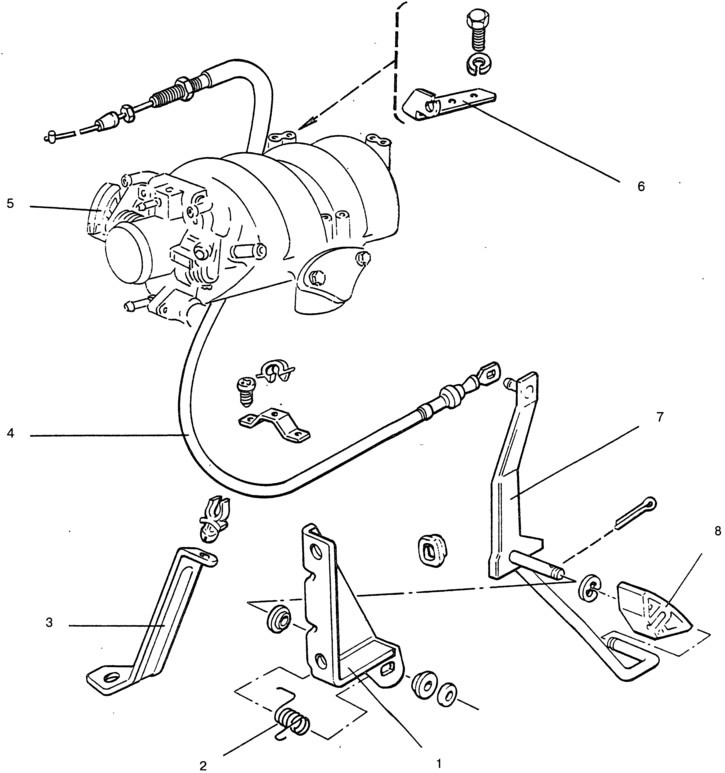
Pic. 9-15. Removing the accelerator drive:
1 - bracket; 2 - return spring; 3 - supporting bracket; 4 - throttle control cable; 5 - bracket for fastening the cable; 6 - sector with a throttle control lever; 7 - throttle control pedal; 8 - pedal pad.
Loosen the two clamps and remove the hose 6 (pic. 9-16) intake pipe by disconnecting the crankcase ventilation hose from its pipe.
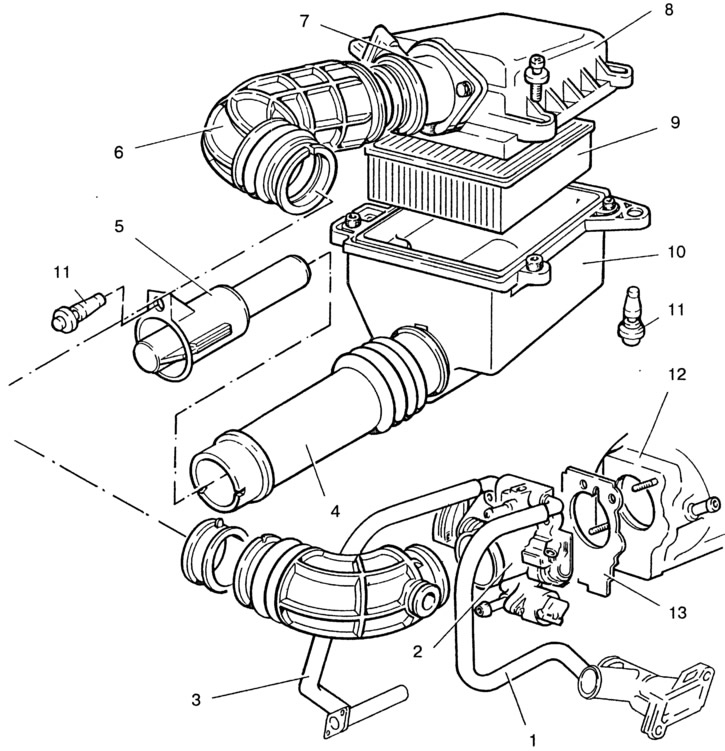
Pic. 9-16. Removing components and parts of the air supply system:
1 - throttle pipe heating hose; 2 - throttle pipe; 3 - hose outlet from the throttle pipe; 4 - air intake; 5 - air intake tip; 6 - inlet pipe hose; 7 - mass air flow sensor; 8 - air filter cover; 9 - filter element; 10 - air filter housing; 11 - filter support; 12 - receiver; 13 - gasket.
Remove the air filter assembly with the mass air flow sensor 7 by cutting off with a knife three rubber supports 11, with which the filter is attached to the body, and one support for fastening the cold air intake tip to the radiator.
Disconnect vacuum hoses from the receiver to the fuel pressure regulator and to the vacuum brake booster.
Disconnect the canister purge hose from the throttle (if the vehicle has a petrol vapor recovery system).
Disconnect the wires from the throttle pipe, from the ignition module, from the injector harness, from all sensors present on the power unit, and from the reverse light switch on the transmission.
Further, the removal of the power unit is carried out in the usual manner, as described in section 2.
The power unit is installed in the reverse order of removal. The rubber mountings for the air filter are disposable. Therefore, when installing the air filter, install new supports.
After installing the power unit, adjust the accelerator drive. With pedal fully released 7 (pic. 9-15) throttle actuator must be fully closed. Drive cable must be tight. The deflection of the cable from the effort of the hand should be no more than 10 mm. If necessary, adjust the tension of the drive cable with the adjusting nuts of the cable end.
With the accelerator pedal fully depressed to the stop, the throttle valve must be fully open, the throttle valve bracket 5 must not have additional travel.
Check the operation of the injection system as specified in the Multiport Fuel Injection System Repair Manual.
Engine disassembly and assembly
The main differences in disassembly and assembly of the engine are associated with a different design of the air supply system.
After installing the engine on the stand and draining the oil from the crankcase, disassemble the engine in the following order.
Disconnect from the throttle pipe 2 (pic. 9-16) hoses 1 and 3 for supplying and discharging coolant, as well as a crankcase ventilation hose at idle. Remove the throttle pipe with gasket 13 by unscrewing the nuts securing it to the receiver 12.
Remove tubes 9 and 1 (pic. 9-14) for supplying and draining fuel by disconnecting them from the rail of 10 injectors, the fuel pressure regulator and from the bracket on the receiver. Remove vacuum hose 6 (pic. 9-17), disconnecting it from the nozzles on the receiver 8 and the fuel pressure regulator 5.
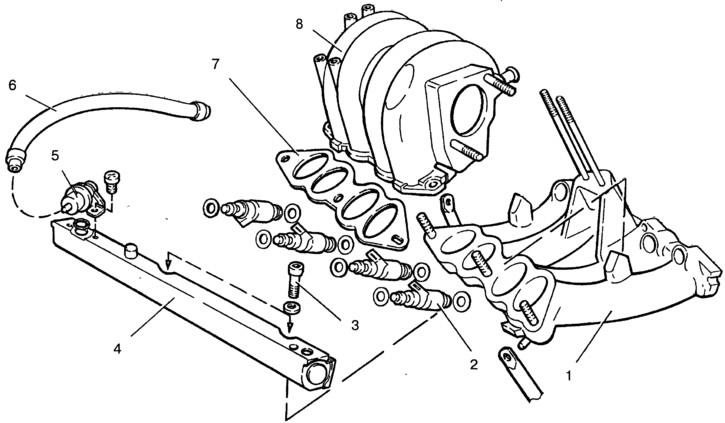
Pic. 9-17. Removing the elements of the power system:
1 - inlet pipe; 2 - nozzle; 3 - bolt; 4 - nozzle ramp; 5 - pressure regulator; 6 - vacuum hose; 7 - gasket; 8 - receiver.
Remove the receiver with gasket 7 by unscrewing the five nuts securing it to the inlet pipe 1.
Disconnect the wiring harness from the injectors, remove the rail 4 of the injectors with the pressure regulator 5 by unscrewing the two bolts 3 fastening to the inlet pipe.
Having unscrewed the nuts and fastened bolts, remove the brackets, and then the intake pipe with the screen.
Remove the ignition module and knock sensor from the left side of the engine.
Further disassembly of the engine is carried out in the usual manner, as indicated in the 2nd section of this manual.
The engine is assembled in the reverse order of disassembly. Lubricate the injector O-rings with engine oil before installing the fuel rail.
Features of the valve mechanism
Valves 2 (pic. 9-18) are actuated by camshaft cams through levers 3. At one end, the lever presses on the valve, and at the other it rests on the spherical head of the hydraulic support 6. The hydraulic supports automatically eliminate the clearance in the valve mechanism, and therefore, during vehicle maintenance, check and adjust the clearance in the valve mechanism, do not required.
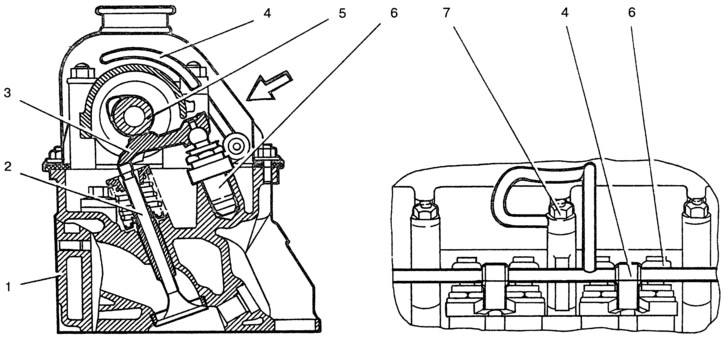
Pic. 9-18. Valve drive mechanism:
1 - cylinder head; 2 - valve; 3 - valve lever; 4 - ramp of the hydraulic support of the pusher; 5 - camshaft; 6 - hydraulic pusher support; 7 - nut.
Oil from the lubrication system through pipe 3 (pic. 9-19) enters the cavity «E» (pic. 9-20) tensioner, then through the hole «D» and valve assembly 2 enters the working cavity «IN» and presses on the plunger 5. In the body 1 of the tensioner there is a hole with a diameter of 1 mm to bleed air into the cavity «E».
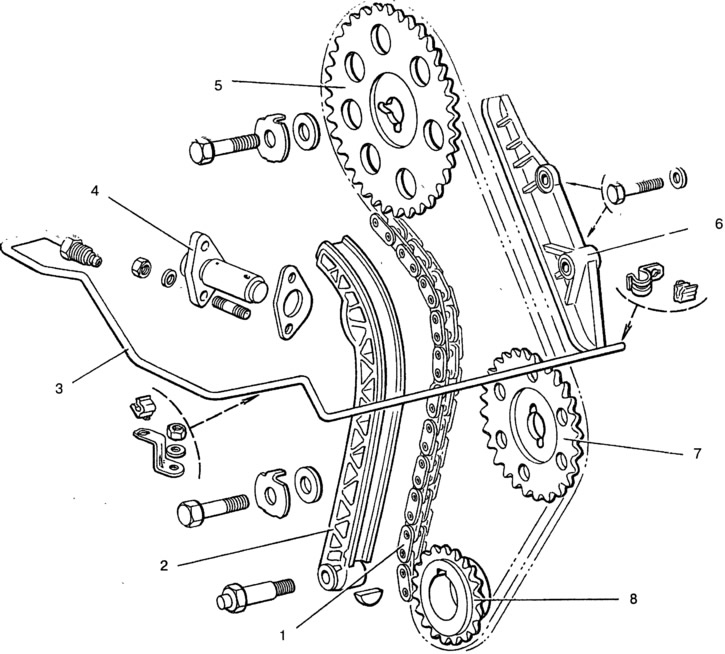
Pic. 9-19. Elements of the chain tension mechanism:
1 - chain; 2 - tensioner shoe; 3 - tube for supplying oil to the tensioner; 4 - chain tensioner; 5 - camshaft sprocket; 6 - calmer; 7 - sprocket of the oil pump drive shaft; 8 - crankshaft sprocket.
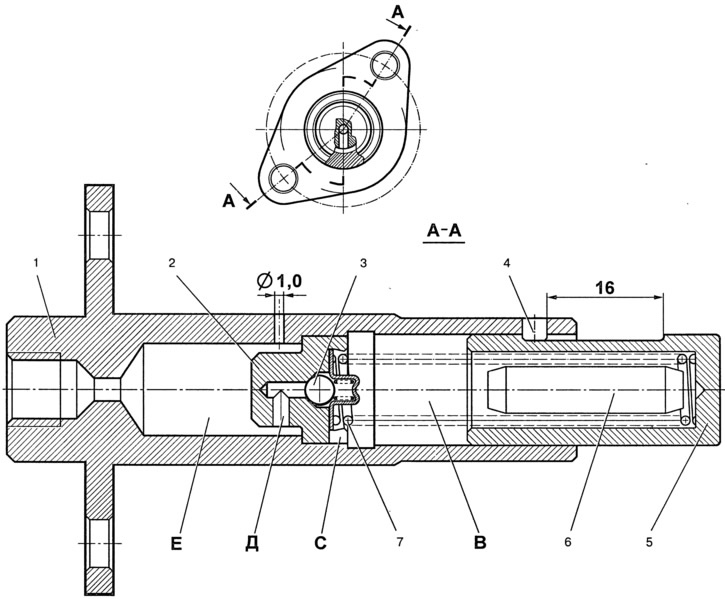
Pic. 9-20. Hydraulic chain tensioner:
1 - tensioner housing; 2 - valve assembly; 3 - check valve ball; 4 - restrictive pin; 5 - tensioner plunger; 6 - volume limiter; 7 - plunger spring; B - working cavity; C - installation groove; D - hole; E - reserve cavity.
The diametral gap between body 1 and plunger 5 should be 0.018-0.024 mm and is measured as the difference between the maximum measured diameter of plunger 5 and the minimum measured diameter of body 1.
When repairing, the tensioner housing and the plunger form a pair, in which the replacement of one part with another after the selection of the gap is not allowed. Plunger 5 must move without jamming in housing 1 by a stroke equal to 16 mm.
When installing on the engine, the tensioner must be free of oil, pin 4 must not protrude from the housing.
